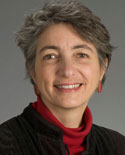 |
|||
| UW School of Public Health Home | Events | Make a Gift | UW Alumni | |||
|
May 2010 | Return to issue home
Sister University Relationship in Iraq Leads to Cancer Research By Amy Hagopian, acting assistant professor, Department of Global Health
In the spring of 2003, when the U.S. invaded Iraq, our UW School of Public Health held a forum on the role of public health in war. Subsequently, we formed a "sister university" relationship with the University of Basra, in southern Iraq, with the intent to bring academic public health professionals together despite the political environment. In the spring of 2005 we welcomed a visiting faculty member from Basra, who told us about elevated rates of cancer and birth defects among her pediatric patients. As a first project of the sister relationship, we decided to work with colleagues in Basra to document the pediatric leukemia rates in the region in a systematic way. We focused on leukemia in part because it is the most common pediatric cancer and could be histologically confirmed. We obtained a Puget Sound Partners grant to support the work. Incidence rates of leukemia in higher income countries are in the range of 4.0 per 100,000 per year and are typically higher than in lower income countries (e.g., 0.9 per 100,000 per year in Vietnam), although these disparities may simply reflect incomplete cancer registration in low income countries. Because Ibn Ghazwan, the teaching hospital in Basra, was the only hospital offering intensive treatment for pediatric cancer patients, its leukemia patient database comprised a virtual regional cancer registry. With the help of colleagues Jenan Hasan and Riyadh Lafta, we documented leukemia cases among children aged 0–14 between 1993 and 2007. Denominator population data were obtained from two sources: a 1997 census and subsequent estimates in an article published in the New England Journal of Medicine. We observed 698 cases of childhood leukemia between 1993 and 2007, ranging between 15 cases (2.6 per 100,000 annual rate) in the first year and 56 cases (6.9 per 100,000 annual rate) in the final year, reaching a peak of 97 cases in 2006 (annual rate of 12.2 per 100,000). Childhood leukemia rates in Basra, then, had more than doubled over the 15-year period. The test for trend was significant (p = 0.03). Basra’s childhood leukemia rates compare unfavorably to those of neighboring Kuwait and nearby Oman, as well as the U.S., the E.U., and other countries. Basra's strategic location in southern Iraq has put it in harm’s way through the Iran–Iraq war (1980–1986), the first Gulf War (1991), subsequent sanctions, and Operation Iraqi Freedom (2003–present). We hypothesize that hazardous exposures during these wars may have been leukemogenic. This research was published in the American Journal of Public Health. Two of the authors, Amy Hagopian and Tim Takaro, went to Basra in May 2009 to present their findings to a Ministry of Health oncology conference. We hope as a next step to obtain funding for a case-control study to compare the potential risk factors of children with leukemia to those of children free of the disease. The sister relationship has generated a positive dynamic between two universities located in countries at war. We believe we demonstrated the value of science and collegiality in creating the conditions for peace. May 2010 | Return to issue home |
|||
|
|||
